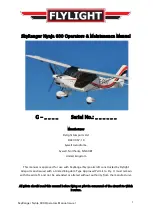
Aircraft Service Manual
Jabiru Aircraft
Pty Ltd
JTM001-1
J120, J160, J170, J200/J400, J230/J430, J250/J450 Variants
REVISION
1
Dated: Nov 2011
Issued By: SW
Page: 87 of 233
8
LANDING GEAR & BRAKES
8.1
GENERAL DESCRIPTION
Main gear comprises two separate composite beams which are bolted to the fuselage at the top and
centre and to the wheel stub at the bottom.
The nose gear is a welded steel, trailing arm assembly with a rubber spring system. The nose wheel
is steerable with the rudder pedals.
Nose Wheel and Main Wheel Speed Fairings (wheel spats) are optional equipment.
Due to space constraints not all different variations are shown herein. When ordering spare parts
provide as must detail as possible
– part description, aircraft model, serial number etc to Jabiru to
ensure accurate part identification.
8.2
MAIN UNDERCARRIAGE REMOVAL (JACKING)
The procedure given in Section 3.2 is useful for wheel/brake servicing or repairs, but is of no value in
removing the main undercarriage. If the removal of the main undercarriage is necessary, adopt the
following procedure:
1.
Manufacture a wing stand. A wing stand is a simple structure standing around 180cm high
– a
frame of 90 x 45 DAR Pine assembled with screws and a diagonal brace is sufficient. One end of
the stand must be padded with foam, thick carpet or similar
– this end of the stand will be
supporting the underside of the wing and must be padded to spread the load and to prevent
scratching the paint etc.
WARNING
When making a wing stand ensure that it is strong and stiff enough to support the aircraft with
minimal distortion.
2.
Remove all unnecessary equipment from the aircraft.
3.
Where equipped, apply a temporary cap to the fuel filler vent of the wing which will NOT be
jacked as a part of this procedure. This is to prevent fuel leaking out the breather onto the wing.
Ensure that the cap is large and highly visible to ensure it is removed when the job is done.
4.
Apply the hand brake or wheel chocks to the wheel which will remain on the ground.
5.
Lifting from a point in line with the wing strut and around 1m (3 feet) further outboard, lift the main
wheel off the ground. More than 1 person may be required, depending on the model and weight
of the aircraft.
6.
Place the wing stand under the wing and allow it to take the weight of the aircraft.
7.
If the aircraft is to remain on the stand for more than 24 hours it is recommended that alternate
supports
– such as trestles under the fuselage belly – be used to relieve the strain on the wing
and undercarriage.
WARNING
Only jack 1 undercarriage leg at a time using this method. If both legs must be removed
simultaneously, support the aircraft on trestles or similar supports under the fuselage belly.
WARNING
When supporting the aircraft by trestles under the belly ensure that that trestle is padded and
located under the wing strut beam, undercarriage channel or similar hard point on the fuselage
structure. Carelessly positioned trestles can easily damage the aircraft.
Ensure that the aircraft is stable and supported so that it cannot tip off the trestles.
















































